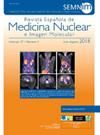Terapia de ablación con yodo radiactivo de baja dosis (1,11 GBq) para el cáncer de tiroides diferenciado en el oeste de Turquía
IF 1.6
4区 医学
Q3 RADIOLOGY, NUCLEAR MEDICINE & MEDICAL IMAGING
Revista Espanola De Medicina Nuclear E Imagen Molecular
Pub Date : 2024-11-01
DOI:10.1016/j.remn.2024.500055
引用次数: 0
Abstract
Objective
Ablation therapy is employed in low-risk differentiated thyroid cancer (DTC) cases to facilitate patient monitoring by reducing thyroglobulin (Tg) levels to measurable levels below after surgery by eliminating residual thyroid tissue. However, there is still uncertainty about the minimum activity dose required for effective ablation. Opting for low-dose [131I]NaI for ablation offers several advantages for both patients and healthcare services. Particularly in this tumor group with a high life expectancy (approximately 90-95% at 10 years) [131I]NaI treatment should not pose a risk to the patient's post-treatment life and should not compromise their quality of life. However, there is a need for a well-defined identification of factors predicting successful ablation.
Methods
Clinical data, laboratory findings, and imaging tests of 287 patients with low-dose 1110 MBq (30 mCi) [131I]NaI ablation therapy for DTC were retrospectively reviewed. Post-ablation imaging and laboratory findings categorized ablation success/failure. The successful ablation group was determined according to the excellent response criteria outlined in ATA criteria. Relationships between clinical, pathological findings, biochemical common variables, and treatment failure were analyzed.
Results
An excellent response was achieved in 77% of the entire group according to ATA criteria post-ablation. Male gender and high Tg levels on the day of ablation (Tg cut-off: 10 ng/ml and 5.35 ng/ml) were associated with unsuccessful ablation.
Conclusions
Our results indicate that a 1110 MBq (30 mCi) ablation dose is sufficient to achieve an excellent response in most low-risk DTC cases 6-12 onths later. When selecting the dose for ablation, besides the histological markers mentioned in guidelines and age, we observed that stimulated Tg values and gender may be important in predicting ablation success.
土耳其西部分化型甲状腺癌的低剂量(1.11 GBq)放射性碘消融治疗
目的对低风险的分化型甲状腺癌(DTC)病例进行消融治疗,通过消除残留的甲状腺组织,将甲状腺球蛋白(Tg)水平降至术后可测量水平以下,从而便于对患者进行监测。然而,有效消融所需的最小活性剂量仍不确定。选择低剂量[131I]NaI进行消融为患者和医疗服务提供了多项优势。特别是对于预期寿命较长(10 年内约为 90-95%)的这类肿瘤患者,[131I]NaI 治疗不应对患者治疗后的生活构成风险,也不会影响他们的生活质量。方法回顾性研究了 287 名接受低剂量 1110 MBq(30 mCi)[131I]NaI 消融治疗的 DTC 患者的临床数据、实验室检查结果和影像学检查。消融后的造影和实验室检查结果分为消融成功/失败两类。成功消融组是根据 ATA 标准中概述的极佳反应标准确定的。分析了临床、病理结果、生化常见变量与治疗失败之间的关系。结果 根据 ATA 标准,77% 的患者在消融术后获得了极佳反应。结论我们的研究结果表明,1110 MBq(30 mCi)的消融剂量足以使大多数低风险 DTC 病例在 6-12 个月后获得极佳反应。在选择消融剂量时,除了指南中提到的组织学标志物和年龄外,我们还发现刺激 Tg 值和性别可能是预测消融成功的重要因素。
本文章由计算机程序翻译,如有差异,请以英文原文为准。
求助全文
约1分钟内获得全文
求助全文
来源期刊

Revista Espanola De Medicina Nuclear E Imagen Molecular
RADIOLOGY, NUCLEAR MEDICINE & MEDICAL IMAGING-
CiteScore
1.10
自引率
16.70%
发文量
85
审稿时长
24 days
期刊介绍:
The Revista Española de Medicina Nuclear e Imagen Molecular (Spanish Journal of Nuclear Medicine and Molecular Imaging), was founded in 1982, and is the official journal of the Spanish Society of Nuclear Medicine and Molecular Imaging, which has more than 700 members.
The Journal, which publishes 6 regular issues per year, has the promotion of research and continuing education in all fields of Nuclear Medicine as its main aim. For this, its principal sections are Originals, Clinical Notes, Images of Interest, and Special Collaboration articles.
 求助内容:
求助内容: 应助结果提醒方式:
应助结果提醒方式:


